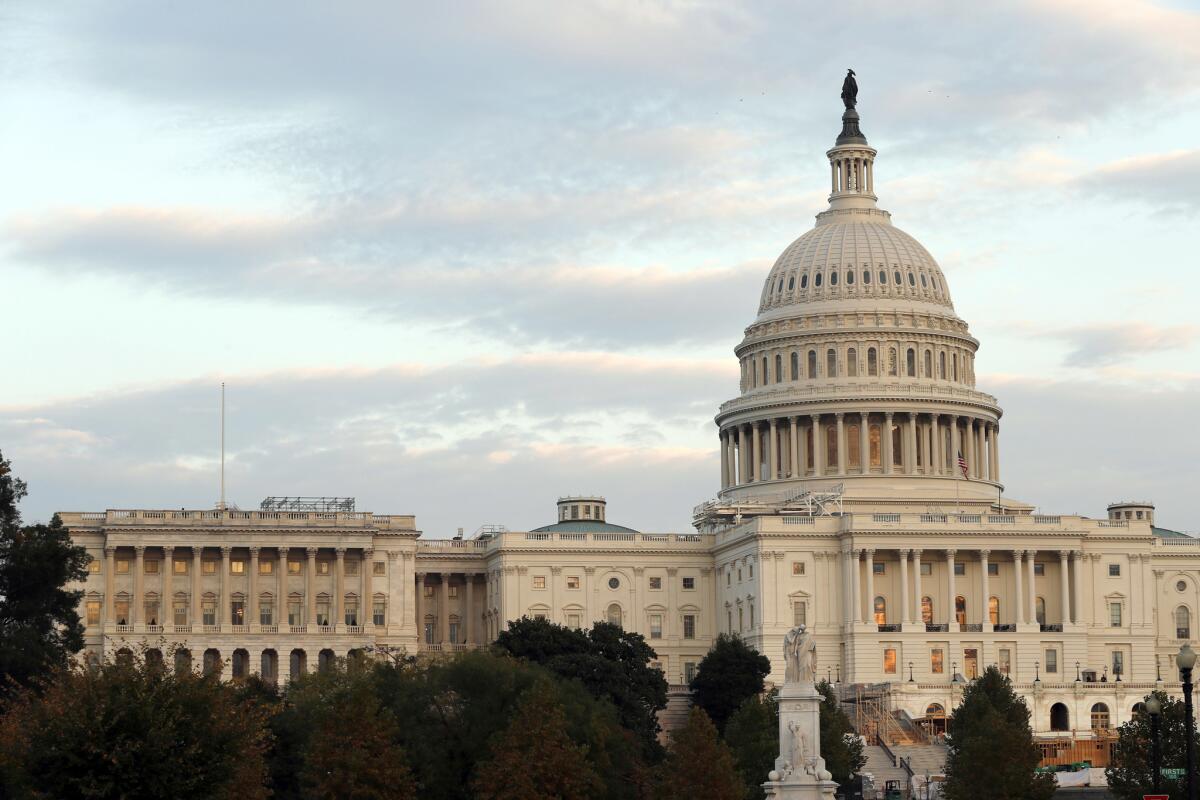Senate approves two-year, $2.7-trillion government spending bill

- Share via
WASHINGTON — The Senate on Thursday approved a $2.7-trillion spending agreement negotiated between Speaker Nancy Pelosi and the White House, sending the deal to President Trump’s desk for his signature.
The bill passed 67-28, with the support of 38 Democrats and 29 Republicans. It was approved with more Democratic support than Republican, a potential embarrassment for the White House in the GOP-controlled chamber.
GOP leaders and the president were lobbying Senate Republicans this week to support the plan, hoping to soften the optics of a Pelosi-White House-negotiated bill passing on Democratic votes. Republicans were focused on ensuring that the “majority of the majority” party supported the measure, a hurdle they were able to overcome.
“He’s been involved, yes,” Sen. John Thune (R-S.D.), the Senate GOP whip, said of Trump’s role in the last-minute lobbying.
An hour before the vote, Trump tweeted another endorsement of the plan, calling it “phenomenal for our Great Military, our Vets, and Jobs, Jobs, Jobs! Two year deal gets us past the Election.”
And in a nod to the biggest GOP critique of the plan — that it doesn’t do enough to limit spending — Trump said there would be an opportunity to do so later.
“Go for it Republicans, there is always plenty of time to CUT!” he added.
“We need to support the president on this,” said Sen. Mike Rounds (R-S.D.), one of the GOP senators who said Wednesday he would back the plan. The White House and congressional leadership, he said, have “done the best they can to come up with an agreeable solution in divided government.”
The plan will raise the nation’s debt ceiling through 2021 as well as raise caps on federal spending for the next two years. Lawmakers will still have to enact additional legislation to determine how and where the money will be spent.
The agreement eliminates the chance of political chaos around raising the debt ceiling, a task that has become politically more perilous in recent years as Republicans have demanded cuts to go along with raising the debt limit. The next time the debt limit will have be raised will be mid-2021, after the next presidential election.
Many Republicans voiced opposition to the plan for lifting the spending caps, resulting in $320 billion more spending, with only $77 billion in cuts.
Sen. Rand Paul (R-Ky.) dubbed the bill’s passage the “final nail in the coffin” of the tea party movement and fiscal responsibility.
“Adoption of this deal marks the death of the tea party,” he said on the Senate floor. “Where are the fiscal conservatives? What happened to the tea party movement?”
Republicans were torn between supporting a White House-approved plan that eliminated caps on defense spending — a significant GOP priority — and supporting a Pelosi-approved plan that raised the debt limit and resulted in new spending for domestic programs.
Senate Majority Leader Mitch McConnell (R-Ky.) tried to frame the deal as the best compromise possible in a divided government. And he stressed the importance of avoiding the “chaos” that would come if the government defaulted on its debts.
“I am confident it is not exactly the legislation that either side of the aisle would have written if one party held the White House, the House, and had 60 votes in the Senate. That’s divided government,” he said on the Senate floor this week. “But I am equally confident that this is a deal that every one of my colleagues should support.”
House Republicans weren’t wild about the plan, either. The spending agreement was passed by the House last week in a 284-149 vote, with 219 Democrats and 65 Republicans approving it.
More to Read
Get the L.A. Times Politics newsletter
Deeply reported insights into legislation, politics and policy from Sacramento, Washington and beyond. In your inbox twice per week.
You may occasionally receive promotional content from the Los Angeles Times.











